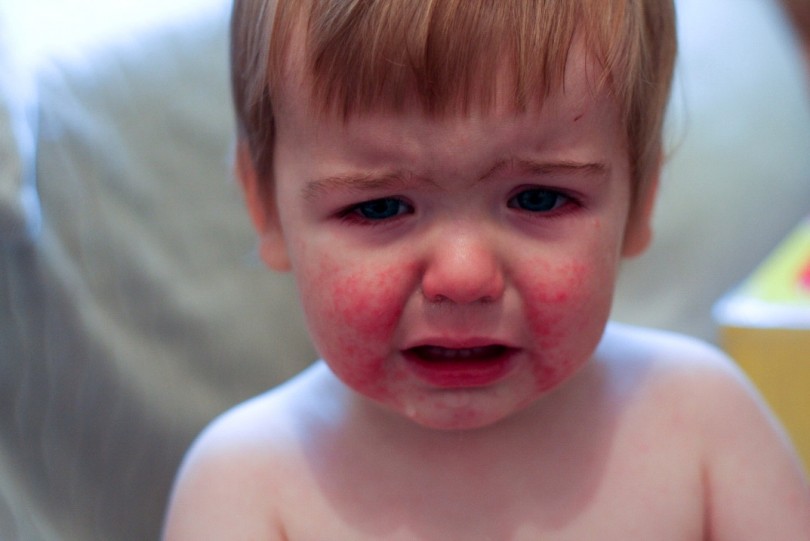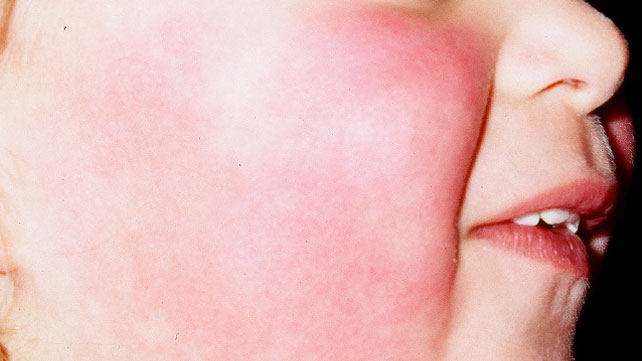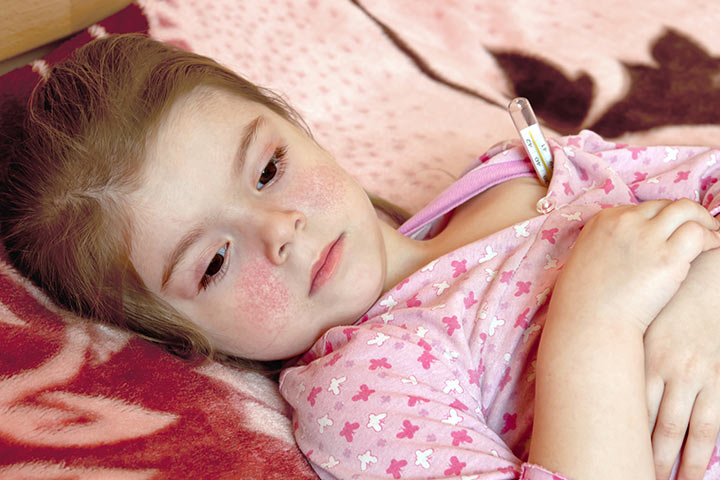Fifth disease, also known as erythema infectiosum, is a viral infection commonly affecting school-age children. From mild to moderate contagious, the disease occurs especially in the winter and spring. It is also called slapped-cheek disease because of the characteristic initial appearance of bright red cheeks when a child is slapped.
Fifth disease is called so because it was the fifth on the list of six recognized childhood rash-forming diseases that included chicken pox, rubella, scarlet fever, roseola infantum, and measles.
Usually mild, this infection is spread through the blood or respiratory droplets entering the air when an infected person coughs or sneezes. The infants and adults are at lower risk of having the condition with exceptions being pregnant women and certain types of chronic anemia.
Here are the symptoms, cause, diagnosis and treatment of the fifth disease.
Cause of Fifth Disease

Parvovirus B19 is an airborne virus that spreads through saliva and respiratory secretions of an infected person and causes the fifth disease. Though it can occur at any time of the year and among people of any age, it is more prominent in school-age children and during the winter, spring and early summer seasons.
Several adults have antibodies that prevent them from having fifth disease because of the earlier exposure in the childhood. However, when people catch it as adults, the symptoms may be severe.
When a pregnant woman becomes infected in the first half of pregnancy, a risk of severe anemia in fetus could be there and 10% risk of miscarriage. The unborn baby may even be at the serious risk of life-threatening anemia.
For the children having healthy immune systems, this condition is a mild one with lasting consequences in rare cases. Child-care providers, teachers and health care professionals working with young children are more likely to have this infection.
Signs & Symptoms Of The Slapped-cheek Disease

The early symptoms of the fifth disease resemble that of flu. They usually include:
- Fatigue
- Nausea
- Sore throat
- Runny and stuffy nose
- Headache
- Low-grade fever
The incubation period (the time when the signs/symptoms of illness start to appear) is mostly 4-14 days but can even extend to 21 days. After a few days of having symptoms, most people develop a red rash that begin with cheeks. These rashes gradually spread to arms, trunk and legs of the body in a few days and may last for weeks. Around the time when the rash appears, the children’s infection is no more contagious and they may attend the school or daycare.
The rash is more common in children than in adults. As a matter of fact, the main symptom that adults usually experience is joint pain. The joint pain can last for many weeks and is usually occurs in the wrists, knees, and ankles.
Long-Term Complications

For most of the healthy people, the fifth disease does not have long-term complications. However, you might need doctor treatment if you have a weak immune system because of chemotherapy, HIV or other conditions.
If you have any type of anemia, you are likely to need medical attention. That’s because it can prevent your body from producing RBCs (red blood cells), reducing the amount of oxygen that tissue gets. This is particularly more likely in people having sickle cell anemia.
This disease can be harmful to unborn child, cause anemia in them and can even become life-threatening if a pregnant woman has this condition.
If needed, blood transfusion can be offered by doctor to help protect the unborn baby from having this disease. Some other pregnancy-related complications may include heart failure, miscarriage and stillbirth.
Diagnosis of Erythema Infectiosum

Nearly half the adults are immune to the parvovirus infection and that is most likely because of a previous childhood infection. The people at the risk of severe complications may be recommended blood test by doctor to determine if they are immune to parvovirus or got recently infected.
And often, the doctors diagnose it by just looking at the rash. A test may be conducted to check for particular antibodies in case of serious complications from the fifth disease. This is especially done for pregnant women or people with a weakened immune system.
Treatment

In case of a parvovirus infection without any complications, self-care treatment is usually sufficient when provided at home. It aims to relieve the signs and symptoms and eases the discomfort. Taking a lot of rest and drinking lots of fluids can help.
The people having severe anemia may require hospitalization and receive blood transfusions. And those who have weakened immune systems may be given antibodies via immune injections for treating the infection.
The acetaminophen (Tylenol and others) is often advised by the doctors for relieving high fevers of more than 102 degrees Fahrenheit (39 degrees Celsius). It can also relieve headaches, minor aches and pains in the joints. The body usually takes 1-3 week sto fight off the parvovirus infection.
The children are often allowed to go back to school once the red rash appears as they are not contagious anymore. In rare cases, intravenous immunoglobulin (IVIG) can be administered and is reserved for severe, life-threatening situations.
Aspirin should be used with caution when they are given to teens and children. Though it is approved for use in children above 3 years of age, the children and teenagers who are recovering from chickenpox or flu-like signs and symptoms should not take aspirin.
Image Source:
1. news
2. healthline
3. hellodoktor
4. momjunction
5. brockpress

